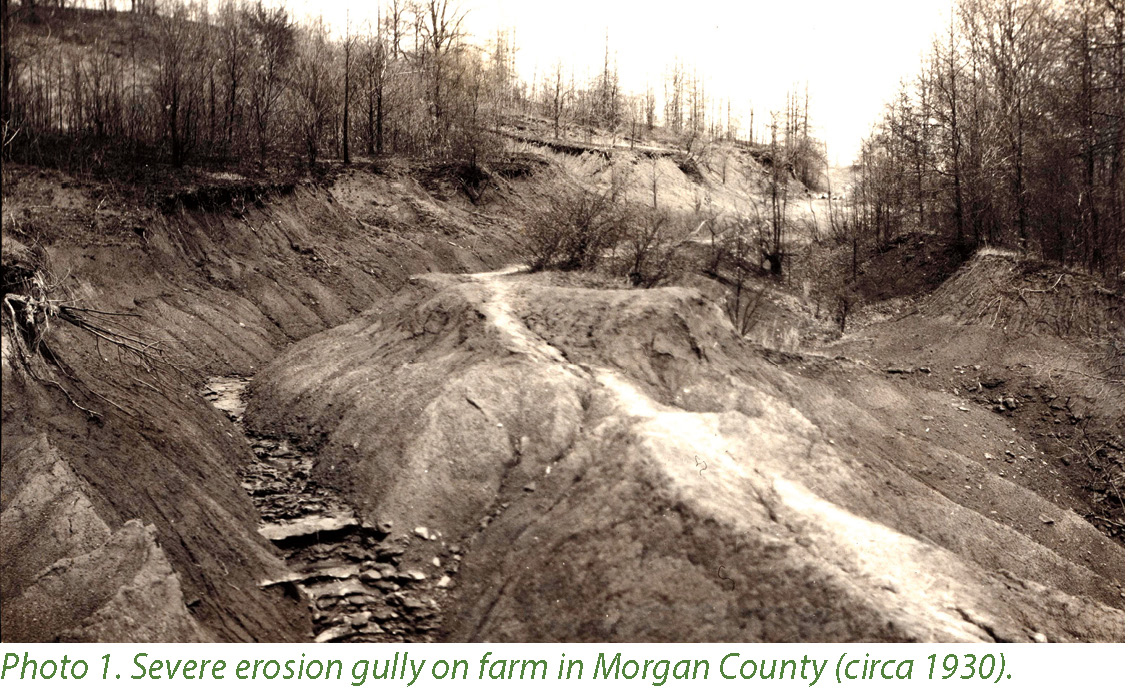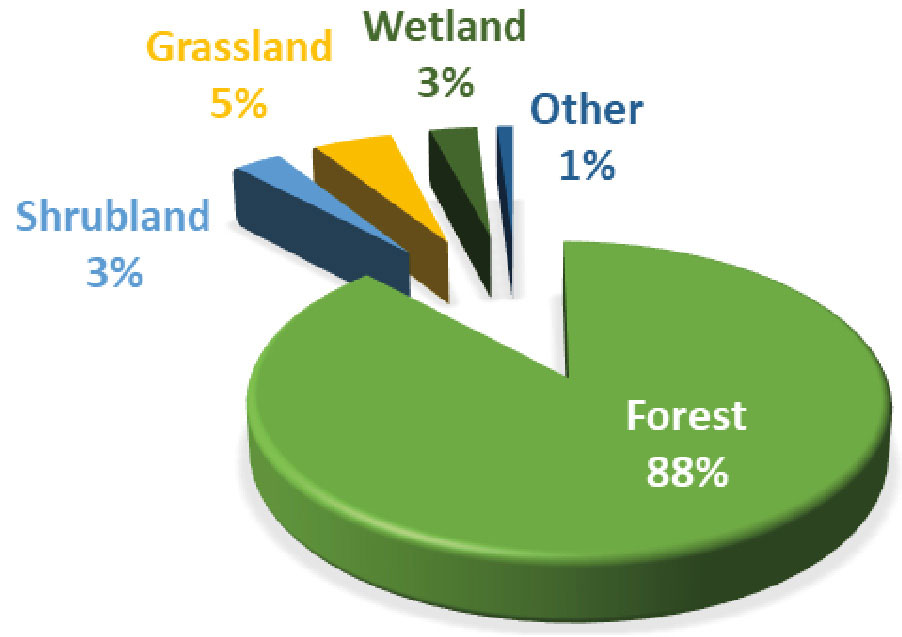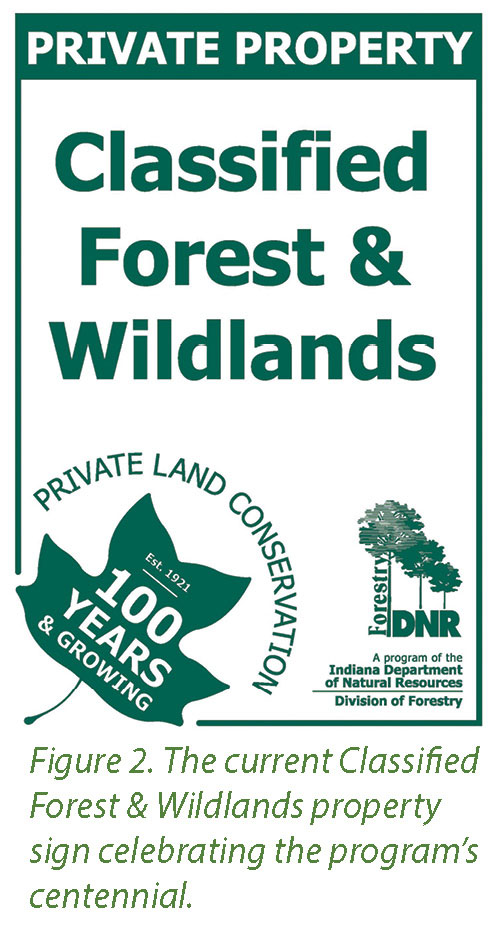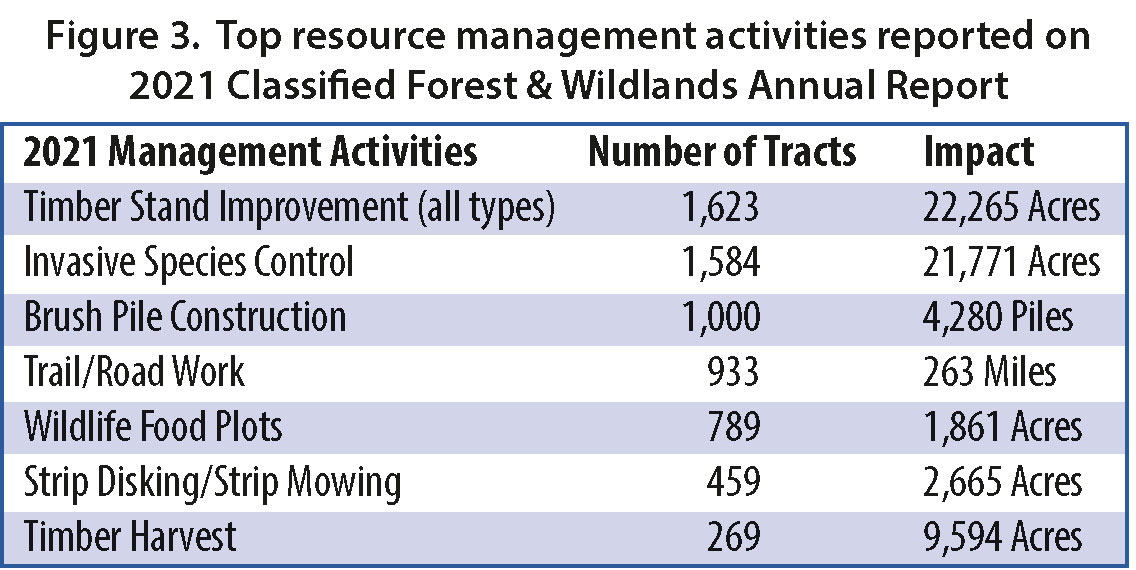Private Land Conservation: Classified Forest & Wildlands Program
The Classified Forest & Wildlands program is one of the longest running and most successful private land conservation programs in the nation. There are now just under 860,000 acres and 13,000 landowners enrolled.
Before European settlement, the 22.4 million acres now known as the state of Indiana was around 80% forested. By 1920, only 6% remained forested. The forests had been burned indiscriminately to open land for agriculture. They had been cut to provide timber for Indiana’s growing cities and infrastructure. Remaining woodlots were frequently pastured with cows or hogs. There was concern that Indiana would become a treeless state. The denuded hillsides of southern Indiana eroded, causing gullies so severe (Photo 1) that they can still be seen on the landscape today. This is the environment in which the Classified Forest program began.
 In spring of 1921, the state legislature passed the law that created the program. The purpose was to encourage Hoosiers to keep their existing forests and to grow more. In return for providing society with the benefits of having forest (timber, clean water, wildlife habitat), landowners received a property tax reduction. In 1921, a participant only had to have 3 acres of land instead of the current 10-acre minimum. Back then, the property didn’t even have to have trees at the time of enrollment. Landowners had three years to get trees established.
In spring of 1921, the state legislature passed the law that created the program. The purpose was to encourage Hoosiers to keep their existing forests and to grow more. In return for providing society with the benefits of having forest (timber, clean water, wildlife habitat), landowners received a property tax reduction. In 1921, a participant only had to have 3 acres of land instead of the current 10-acre minimum. Back then, the property didn’t even have to have trees at the time of enrollment. Landowners had three years to get trees established.
In 1979, the legislature created a sister program called the Classified Wildlife Habitat program. As the name implies, the focus of the program was conserving privately owned lands (grasslands, shrublands, wetlands, small woodlots) for wildlife. In addition, the program also promoted protecting watersheds and preventing soil erosion. The minimum acreage requirement was 15 acres.
In 2006, as part of an effort to reduce redundancy in state government, the two programs were merged into the present-day Classified Forest & Wildlands program. The current program has a minimum acreage of 10 contiguous acres that can be made up of a variety of habitats (Figure 1).
 The program benefit that initially draws most landowners to the program is still the property tax reduction. Lands in the program currently pay $0.15 -$0.35 per acre in property taxes. The actual tax per acre depends on specific county’s tax rate. In comparison a property not enrolled in the program could have taxes $1.50 - $30+ per acre depending on if the land is considered agricultural land or excess residential land.
The program benefit that initially draws most landowners to the program is still the property tax reduction. Lands in the program currently pay $0.15 -$0.35 per acre in property taxes. The actual tax per acre depends on specific county’s tax rate. In comparison a property not enrolled in the program could have taxes $1.50 - $30+ per acre depending on if the land is considered agricultural land or excess residential land.
There are additional benefits of being enrolled in the program. Enrolled landowners receive a free property management plan and access to their district forester, a state employed professional forester who works with private landowners, on a regular basis. District foresters meet with landowners one-on-one a minimum of once every seven years, walk the property, provide management suggestions based on the landowner’s and the program’s objectives, and provide information about sources of funding to accomplish those activities. The district forester then writes the information into a management plan which the landowner can refer to as needed.
The Division of Forestry is always looking for ways to expand program benefits. In 2010, forest certification for enrolled forests was added. Companies and consumers around the world want to know that their wood products are coming from well managed forests. Forest certification is a way to prove that the forest is managed in a way that provides forest products while also protecting for water, soil, plant, wildlife, and special features. There are companies that look to buy timber from certified forests. This benefit opens the certified timber markets to classified landowners at no cost. More than half of classified landowners (446,000 acres of forest) have taken advantage of forest certification.
In return for the benefits of the program, the landowner agrees to several things. They must follow their management plan. However, the management plan is a living document. As conditions on the property or landowner goals change, the plan can be updated. The landowner also agrees to a return a survey every year updating the Division of Forestry on what was accomplished on the property the previous year. The landowner must also post Classified Forest & Wildland signs (Figure 2).
There are limitations on what activities can occur on a classified property, but landowners are often pleasantly surprised by what is allowed and even encouraged. Classified land cannot be used to grow crops including hay, graze animals, or have buildings. Classified land can be use for wildlife food plots, hunting, timber, camping, and trails provided the activity is in line with the management plan and precautions are taken to minimize impacts.
Entering the program or purchasing classified land should not be taken lightly. When classified land transfers ownership, the classified status remains with the property. Land remains classified until a landowner voluntarily removes it or the Division of Forestry removes it for noncompliance. There are fees for withdrawing land from the program - up to ten years of back taxes with 10 percent interest for all tracts plus $100 flat fee and $50 per acre for tracts enrolled after June 2006. Whoever is the owner at the time of the withdrawal is responsible for the fees. Even if the landowner only owns the property for one day when they decide to withdraw, they are responsible for all the withdrawal fees. The fees serve as a disincentive for new owners to remove land from the program.
Classified landowners are doing resource management across the state. Based on the 2021 landowner report, 24% of classified tracts had a least one management activity completed on it during that year. The top three most frequently reported management activities were timber stand improvement (TSI), invasive species control, and brush pile construction for wildlife. Figure 3 provides list of management activities and reported impact. Impact in the table understates the accomplishments as some landowners do not include amount of work accomplished on their annual report.
The Classified Forest & Wildland program has been Indiana’s most important private land conservation program for over a century. The program was successful in its earliest purpose of returning forests to the Indiana landscape. The mission for the next hundred years is to keep and expand well managed forests and wildlife habitats for the future generations of Hoosiers.
Brenda Huter is a stewardship coordinator with the IDNR Division of Forestry. Brenda’s career with the Division of Forestry began at Yellowwood State Forest where she served as a GIS Intern and later became a Resource Specialist. She assumed her current duties in 2004. She also serves as a meeting facilitator and is trained in wildland firefighting.
